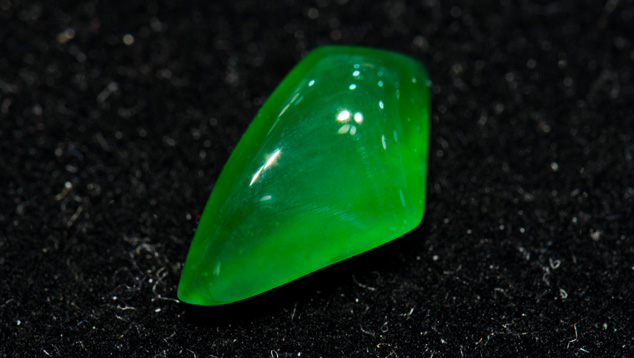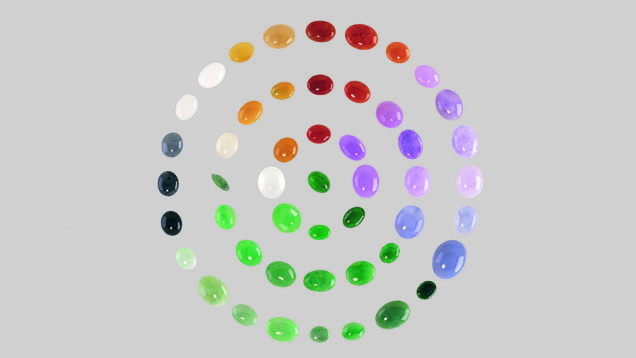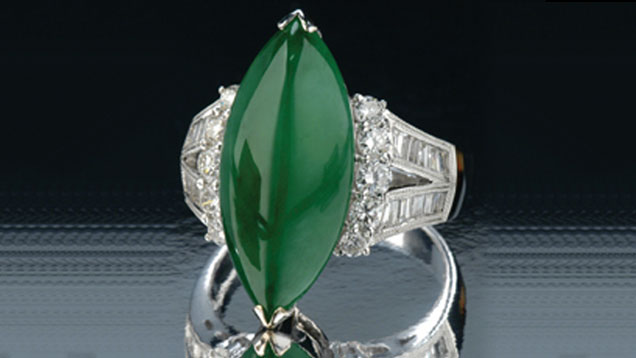Jadeite Jade Quality Factors -- GIA
( Reprint From GIA )

The price for fine-quality jadeite has risen dramatically along with China’s economic rise. The demand from those who can newly afford it has significantly outpaced the supply of this rare material.
The Chinese have revered jadeite’s fine green color since its discovery in Burma. Top-quality jadeite is rare. Vivid, sleek, and translucent, magnificent jadeite commands some of the highest prices among gems in today’s international market.
Jadeite’s three most important qualities, in order of their impact on its market value, are color, transparency, and texture.
When jadeite buyers evaluate fashioned jadeite, they consider many factors. First, they judge its color under both fluorescent and incandescent light sources. They check its level of transparency. They look for even coloration or a pleasing mottling of colors. They also look for fine polish and undistorted surface reflections. Clarity is important, too, because any fractures can strongly affect value.
Color
Color is jadeite’s most important value factor. Because consumers traditionally associate jadeite with the color green, it surprises some people to learn that it comes in other colors as well—lavender, red, orange, yellow, brown, white, black, and gray. All of these colors can be attractive. But jadeite’s most desirable color is, in fact, a very specific shade of green.

The green that can command millions of dollars in the marketplace is pure and penetrating, a vivid hue with no hint of gray that looks intense even from a distance. It ranges from pure green to a slightly bluish green or a slightly yellowish green.
Other highly valued jade varieties include “kingfisher jade,” with a green color that’s only slightly less vivid than Imperial; “apple jade,” which is an intense yellowish green; and “moss-in-snow jade,” which is translucent white with bright green veining, patches, or spots. The most outstanding examples of these are almost always bought and sold in the Asian market.
Lavender is the next most valuable color. Intense colors command a substantial premium over lighter and weaker colors. Black jade is also popular, along with orange to reddish jade, especially when these colors are not brownish.
Transparency
Jadeite’s transparency ranges from completely opaque to semitransparent. The best jadeite is semitransparent, meaning the text you can read through it would be slightly blurred. Because light penetrates below the surface, semitransparent jadeite has an alluring brilliance. It almost appears to glow, increasing the charm of a lush green or rich lavender hue. The least desirable jadeites are completely opaque or have opaque or cloudy patches that break up their transparency.
To judge transparency, some buyers place a thin jadeite slice on a printed page and try to read the print through the gem. If the transparency is excellent, the viewer can see the print easily, even if the jadeite is dark green. Good transparency can sometimes compensate for lack of uniform color or low color saturation.

Texture
Jadeite has a smooth, even texture that makes people want to touch and hold it. Jadeite’s texture can be fine, medium, or coarse, depending on variations in crystal size and hardness. These texture categories are sometimes called, respectively, old mine, relatively old mine, and new mine.

The same crystal structure that contributes to jadeite’s texture also contributes to its exceptional toughness. Jadeite’s interlocking crystals, also called grains, produce a tightly inter-grown, compact mass that bonds together and resists breaking. In the early days of its history, when it was used to fashion tools and weapons, jadeite’s ability to withstand breakage was one of its major advantages.
Cut
China is the world’s main polishing center for jadeite. Some jadeite from Myanmar is fashioned near its source, in cutting workshops near the open jade markets of Hpakan, Lonkin, Mogaung, and Mandalay. Many cutters there still polish jadeite the ancient way, using a hollow bamboo lathe treated with sand and water.

Manufacturers fashion jadeite into a handful of distinctive, traditional jewelry forms. Some are hololiths, carved entirely from a single piece of rough. Hololiths include bangles, rings, and pendants.

Fine-quality jadeite might also be cut into round beads, which are carefully selected and strung into strands. Color and texture are the most important factors for matching jadeite beads. Manufacturers also match transparency, size, and symmetry of cut. Because matching is difficult, especially for color, longer strands or larger beads can sell for extremely high prices.
The jade bangle, first carved in China from nephrite, is a style thought to date back at least four thousand years. A smooth circle of bright jadeite wrapping the wrist is thought, even today, to bring peace and protection to its wearer. Jadeite bangles can be highly important pieces of jewelry.
Some bangles are hololiths. When a cutter fashions a bangle from a single piece of rough, a great deal of weight loss results. For this reason, hololith bangles cost more than bangles that consist of several pieces joined together by precious-metal hinges.
The Chinese eternity symbol, or bi, bears great spiritual significance for many jadeite connoisseurs. The shape is simple: a convex or plump disk with a round hole in its center. Ideally, the jadeite should be more than twice as wide as the hole.
Jadeite rings are often simple all-jadeite bands. The finest bands show uniform color all the way around. A variation on this is the saddle ring, a solid band with a carved rectangular-shaped top.
Size and Weight
Jadeite size is commonly expressed in millimeters. The value of cabochons, beads, and bangle bracelets rises with an increase in size, all other quality factors being equal. With top-quality imperial jadeite, slight differences in size can make large differences in value. With nephrite, larger sizes do not raise the value dramatically in most cases.
Some jadeite is transparent enough to allow the observer to see into the stone, revealing the gem’s depth of color and giving it higher value. - Gift of Sophie LeuJadeite is available in a wide range of sizes for jewelry as well as carvings. - Gift of Sophie LeuWhen jadeite’s structure is fine-grained, the gem has smooth texture and high luster. - Courtesy Mason-Kay Fine Jade Jewelry

## Follow us on Instagram, Facebook, youtube for more information.
Facebook: https://www.facebook.com/baikallajewelry
Facebook group: The Jade Group: https://www.facebook.com/groups/theja...
Instagram: https://www.instagram.com/baikallajew...
Twitter: https://twitter.com/BaikallaJ
Pinterest: https://www.pinterest.com/baikallaj/















































































































